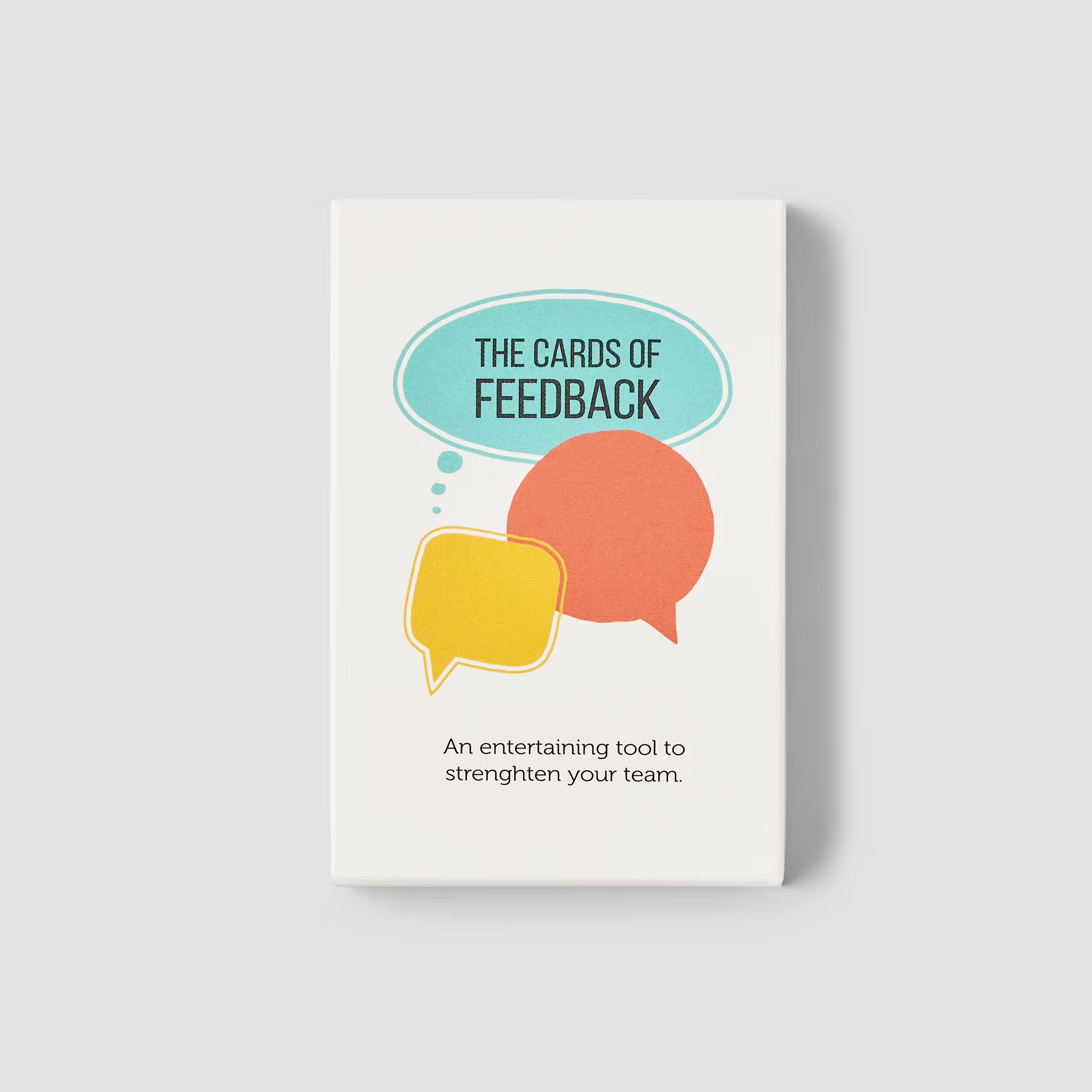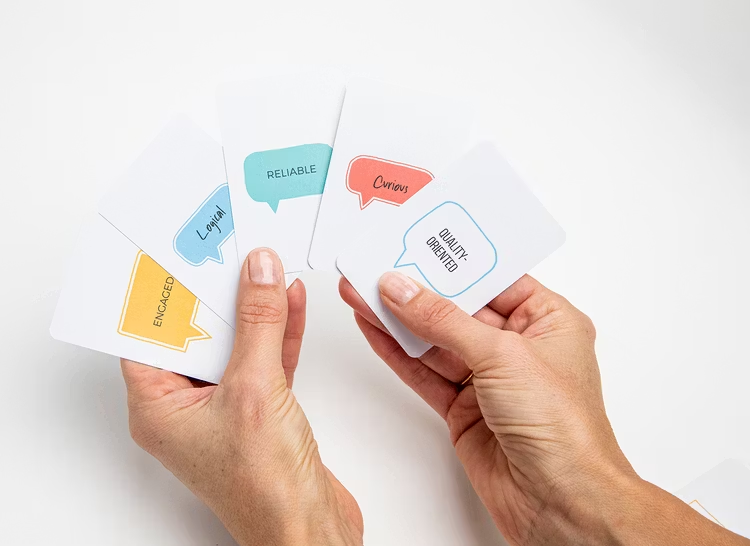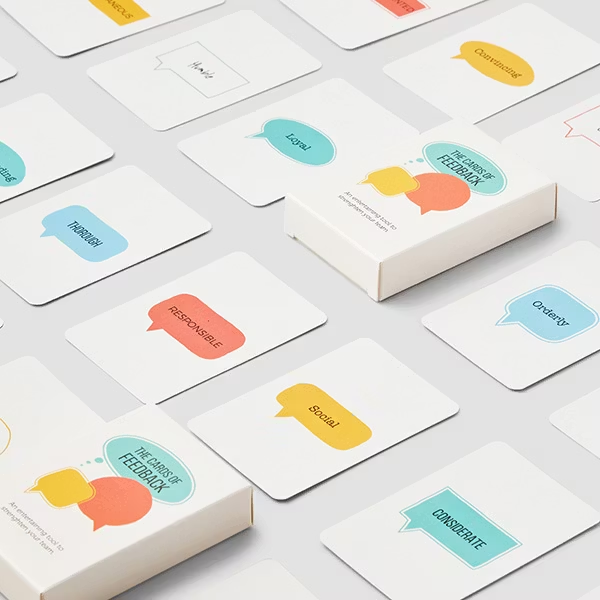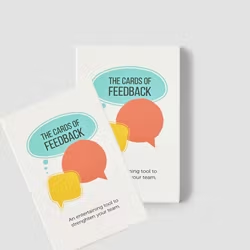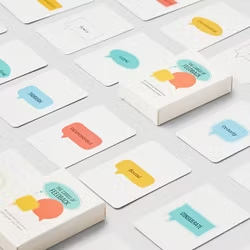The Feedback Card Game is a simple tool that helps teams have meaningful conversations, build engagement, and create safer, stronger group dynamics. By focusing on strengths, we grow as individuals and as a team. The deck contains 52 cards describing positive traits and qualities. Use them to give appreciative feedback or to discover your own strengths.
Three ways to use the game:
1. Quick Feedback – “Fast Version”
Purpose: To give appreciative feedback within the team.
Group size: 3–8 people
Time: Around 30 minutes
Place all cards face up on a table. Each person picks two cards—one for the person on their left and one for the right—based on strengths they notice and appreciate. Hand over the cards with a short explanation, ideally with a concrete example. End with a group reflection.
2. No Idiots – Only Stars
Purpose: To highlight each other's strengths.
Group size: 3–5 people (up to 7 with two decks)
Time: 90–120 minutes
Part 1 – Give and receive feedback
Each person starts by picking two cards that reflect their own strengths, then two for each group member. One by one, everyone gives their cards with explanations and examples. After one round, the rotation changes so that feedback reaches everyone. In the final rounds, each person explains the cards they picked for themselves.
Part 2 – Color interpretation
The cards come in four colors—red, yellow, green, and blue—based on behavior styles. After the feedback round, review the colors of the cards you received. Are all colors represented? Which is most dominant? Share your reflections.
Quick guide to colors:
Red: Goal-oriented, direct, efficient
Yellow: Creative, enthusiastic, visionary
Green: Caring, inclusive, relationship-focused
Blue: Analytical, detail-oriented, structured
Note: These colors are inspired by behavioral models like DiSC, and are meant for reflection—not as a formal assessment.
3. Feedforward
Purpose: To identify and develop behaviors we value and want to strengthen.
Group size: 2–6 people
Time:Around 60 minutes
Each person chooses two cards representing their strengths and two traits they want to develop. Share your strengths first, with examples of how they show up in your behavior. Then share your development areas and ask the group for tips on how to strengthen those traits. Finish with a round where everyone shares one new thing they want to practice going forward.
Three ways to use the game:
1. Quick Feedback – “Fast Version”
Purpose: To give appreciative feedback within the team.
Group size: 3–8 people
Time: Around 30 minutes
Place all cards face up on a table. Each person picks two cards—one for the person on their left and one for the right—based on strengths they notice and appreciate. Hand over the cards with a short explanation, ideally with a concrete example. End with a group reflection.
2. No Idiots – Only Stars
Purpose: To highlight each other's strengths.
Group size: 3–5 people (up to 7 with two decks)
Time: 90–120 minutes
Part 1 – Give and receive feedback
Each person starts by picking two cards that reflect their own strengths, then two for each group member. One by one, everyone gives their cards with explanations and examples. After one round, the rotation changes so that feedback reaches everyone. In the final rounds, each person explains the cards they picked for themselves.
Part 2 – Color interpretation
The cards come in four colors—red, yellow, green, and blue—based on behavior styles. After the feedback round, review the colors of the cards you received. Are all colors represented? Which is most dominant? Share your reflections.
Quick guide to colors:
Red: Goal-oriented, direct, efficient
Yellow: Creative, enthusiastic, visionary
Green: Caring, inclusive, relationship-focused
Blue: Analytical, detail-oriented, structured
Note: These colors are inspired by behavioral models like DiSC, and are meant for reflection—not as a formal assessment.
3. Feedforward
Purpose: To identify and develop behaviors we value and want to strengthen.
Group size: 2–6 people
Time:Around 60 minutes
Each person chooses two cards representing their strengths and two traits they want to develop. Share your strengths first, with examples of how they show up in your behavior. Then share your development areas and ask the group for tips on how to strengthen those traits. Finish with a round where everyone shares one new thing they want to practice going forward.

 English
English
